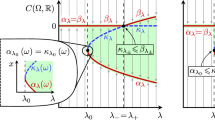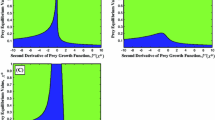Abstract
In this paper, an alternative is proposed for computing fold and cusp bifurcation in a system of two ordinary differential equations depending on one or two parameters. In particular, it is proven that the fold bifurcation point in that system corresponds to a local maximum or minimum of a constrained optimization problem, which can be computed using the classical Lagrange Multiplier Method. Conversely, a sufficient condition is provided so that the solution of a particular constrained optimization problem using the Lagrange Multiplier Method corresponds to a fold bifurcation of two ordinary differential equations. Similarly, for system with two parameters, some sufficient conditions for cusp bifurcation points are also provided. These results are applied to three examples: the Bazykin’s system, a two-dimensional predator–prey system with nonmonotonic response function, and a subsystem of the so-called tritrophic food-chain model. The results are compared with those in the literature and also with the results using the numerical continuation software AUTO. Furthermore, a swallowtail bifurcation is detected in the latter model.






Similar content being viewed by others

References
Baek H (2013) On the dynamical behavior of a two-prey one-predator system with two-type functional responses. Kyungpook Math J 53(4):647–660
Baek H, Kim D (2014) Dynamics of a predator–prey system with mixed functional responses. J Appl Math
Bazykin AD (1985) Mathematical biophysics of interacting populations. Nauka, Moscow
Bo D (2006) Equilibriumizing all food chain chaos through reproductive efficiency. Chaos Interdiscip J Nonlinear Sci 16(4):043125
Dhooge A, Govaerts W, Kuznetsov YA (2003) MATCONT: a MATLAB package for numerical bifurcation analysis of ODEs. ACM Trans Math Softw (TOMS) 29(2):141–164
Doedel EJ, Champneys AR, Fairgrieve TF, Kuznetsov YA, Sandstede B, Wang X et al (1997) Continuation and bifurcation software for ordinary differential equations (with homcont). AUTO97, Concordia University, Canada
Ermentrout B (2002) Simulating, analyzing, and animating dynamical systems: a guide to XPPAUT for researchers and students, vol 14. SIAM, Philadelphia
Gumel AB (2012) Causes of backward bifurcations in some epidemiological models. J Math Anal Appl 395(1):355–365
Harjanto E, Tuwankotta JM (2016) Bifurcation of periodic solution in a Predator-Prey type of systems with non-monotonic response function and periodic perturbation. Int J Non-Linear Mech 85:188–196
Holling CS (1959) The components of predation as revealed by a study of small-mammal predation of the european pine sawfly. Can Entomol 91(5):293–320
Holling CS (1959) Some characteristics of simple types of predation and parasitism. Can Entomol 91(7):385–398
Huang Y, Diekmann O (2001) Predator migration in response to prey density: what are the consequences? J Math Biol 43(6):561–581
Klebanoff A, Hastings A (1994) Chaos in one-predator, two-prey models: general results from bifurcation theory. Math Biosci 122(2):221–233
Kuznetsov YA (1998) Elements of applied bifurcation theory, 2nd updated ed, volume 112
Liu X, Wang J (2015) Codimension two and three bifurcations of a predator–prey system with group defense and prey refuge. Nonlinear Anal 20(1):72–81
Marwan M, Tuwankotta JM, Harjanto E (2018) Application of lagrange multiplier method for computing fold bifurcation point in a two-prey one predator dynamical system. J Indones Math Soc 24(2):7–19
Owen L, Tuwankotta JM (2019) Computation of cusp bifurcation point in a two-prey one predator model using lagrange multiplier method. In: Proceedings of the international conference on applied physics and mathematics 2019. Chulalongkorn University, Bangkok, Thailand
Parshad RD, Upadhyay RK, Mishra S, Tiwari SK, Sharma S (2017) On the explosive instability in a three-species food chain model with modified Holling type IV functional response. Math Methods Appl Sci 40(16):5707–5726
Raw SN, Mishra P, Kumar R, Thakur S (2017) Complex behavior of prey–predator system exhibiting group defense: a mathematical modeling study. Chaos Solitons Fractals 100:74–90
Tuwankotta JM, Harjanto E (2019) Strange attractors in a predator–prey system with non-monotonic response function and periodic perturbation. J Comput Dyn 6(2):469
Tuwankotta JM, Harjanto E, Owen L (2018) Dynamics and bifurcations in a dynamical system of a predator–prey type with nonmonotonic response function and time-periodic variation. In: SEAMS school on dynamical systems and bifurcation analysis. Springer, pp 31–49
Upadhyay RK, Raw SN (2011) Complex dynamics of a three species food-chain model with Holling type IV functional response. Nonlinear Anal Modell Control 16(3):553–374
Wiggins S (2003) Introduction to applied nonlinear dynamical systems and chaos, vol 2. Springer, Berlin
Zhu H, Campbell SA, Wolkowicz GSK (2003) Bifurcation analysis of a predator-prey system with nonmonotonic functional response. SIAM J Appl Math 63(2):636–682
Acknowledgements
Livia Owen’s research is supported by Institute for Research and Community Service and Institute for Development and Innovation, Parahyangan Catholic University. Livia Owen acknowledges the financial support from The Indonesian Education Scholarship Program (LPDP), the Ministry of Finance of the Republic of Indonesia. J.M. Tuwankotta’s research is supported by the research grant P3MI FMIPA ITB 2021 from Institut Teknologi Bandung.
Author information
Authors and Affiliations
Corresponding author
Appendices
Proof of the Theorem 2
Without loss of generality, we assume that \(x_0 = 0\), \(y_0 = 0\), and \(\beta _0 = 0\). Using the Center Manifold Theorem (see [14, 23]) we can reduce System (2) to a single equation on the center manifold. Let us consider the coordinate transformation \(\varvec{\xi } = P \varvec{\nu }\) with:
\(\varvec{\xi } = \left( x, y \right) ^{\scriptscriptstyle T}\), and \(\varvec{\nu } = \left( u, v \right) ^{\scriptscriptstyle T}\).
Applying the transformation to System (2), we derive:
Here:
and
See Eq. (4) for the definition of A and B.
From the Center Manifold Theorem, for sufficiently small \(\delta \) there exists a function:
with \(V(0,0) = 0\), \(V_u (0,0) = 0\), and \(V_{\beta }(0,0) = 0\), so that System (21) can be written as:
where \(V = V(u, \beta )\) to shorten the notation.
All that remains is to check if these two conditions:
- (\(C_1\)):
-
\(h_{\beta }(0,0) \ne 0\), and
- (\(C_2\)):
-
\(h_{uu}(0,0) \ne 0\),
are satisfied. In that case, there exists a time-orientation preserving homeomorphism which maps its orbits of System (3.1) to the orbits of
This last equation is a normal form for fold bifurcation with unfolding parameter: \(\gamma \) (see Theorem 3.2 in [14]).
It is easy to see that
which implies that \(h_\beta (0,0) \ne 0\). Thus \((C_1)\) is satisfied.
Next, by applying the chain rule we have:
and
Let \(\varvec{e_1}\) and \(\varvec{e_2}\) be the unit vectors on x- and y- axis, respectively. Then, since
and
we have: \( f_u(0,0) = 0 = f_v(0,0)\). Since \(V(0,0) = 0\), we conclude that: \(h_u(0,0) = 0\) and
Lastly, from the definition of f in Eq. (22) we derive:
Thus, by the condition in Eq. (6), the nondegeneracy condition \((C_2)\) is satisfied.
Proof of Theorem 3
Recall that we have assumed that
-
1.
\((x_0, y_0, \lambda _0)\) is a solution of System (9), with \(\lambda _0 \not =0\),
-
2.
\(\alpha = \alpha _0\) is a solution of Eq. (11), and
-
3.
we have set: \(\beta _0 = G(x_0, y_0,\alpha _0)\).
Without loss of generality, we assume that \(x_0 = 0\), \(y_0= 0\), \(\alpha _0 = 0\) and \(\beta _0 = 0\). We will use the same notation for the Hessians (A and B), and for the matrix P as in the previous section; however, they are now \(\alpha \)-dependent.
Premise 1 in Theorem 3 guarantees that: \(\displaystyle \eta = F_x(0,0,0) + \lambda _0 F_y(0,0,0) \not =0\). Using a similar argument as in the previous section, we apply the coordinate transformation \(\varvec{\xi } = P \varvec{\nu }\) to System (8). Using the Center Manifold Theorem, we conclude that for a sufficiently small \(\delta \), there exists a function:
with
such that on the center manifold, the dynamics of System (8) is determined by:
where f as is defined in Eq. (22) but adjusted to include the second parameter.
If these four conditions, i.e.
- \((C_1)\):
-
\(h_{u} = 0\),
- \((C_2)\):
-
\(h_{uu} = 0\),
- \((C_3)\):
-
\(h_{uuu} \ne 0\), and
- \((C_4)\):
-
\(h_{\beta } h_{u \alpha } - h_{\alpha } h_{u\beta } \ne 0\),
are satisfied, then System (24) is topologically equivalent to the normal form of cusp bifurcation:
To simplify the notation, we will write V for \(V(u, \alpha , \beta )\), h for \(h(u,\alpha , \beta )\) and f for \(f(u,V(u,\alpha ,\beta ),\alpha )\). Using the chain rule, we compute:
Using a similar argument as in the previous subsection, \(f_u\) and \(f_v\) are both vanishing. Thus, we conclude \((C_1)\).
Next, we compute the derivative of Eq. (25) with respect to u, i.e.:
From Eq. (23), at \((u,\alpha ,\beta ) = (0,0,0)\) we derive: \(h_{uu}(0,0,0) = f_{uu}(0,0,0)\). By premise 2 in Theorem (3) we have:
where A and B are the Hessians of F and G respectively.
Let us carry on with computing the derivative of Eq. (26) with respect to u:
Applying Eq. (23), we have:
Writing,
we have:
where:
all evaluated at (0, 0, 0). Thus, \((C_3)\) follows from premise 3 of Theorem 3.
Lastly, since:
and furthermore:
then, at (0, 0, 0):
Thus, condition \((C_4)\) follows from premise 4 of Theorem 3.
Rights and permissions
About this article
Cite this article
Owen, L., Tuwankotta, J.M. Computation of fold and cusp bifurcation points in a system of ordinary differential equations using the Lagrange multiplier method. Int. J. Dynam. Control 10, 363–376 (2022). https://doi.org/10.1007/s40435-021-00821-4
Received:
Revised:
Accepted:
Published:
Issue Date:
DOI: https://doi.org/10.1007/s40435-021-00821-4
Keywords
- Fold bifurcation
- Cusp bifurcation
- Lagrange multiplier method
- Ordinary differential equations
- Dynamical system



